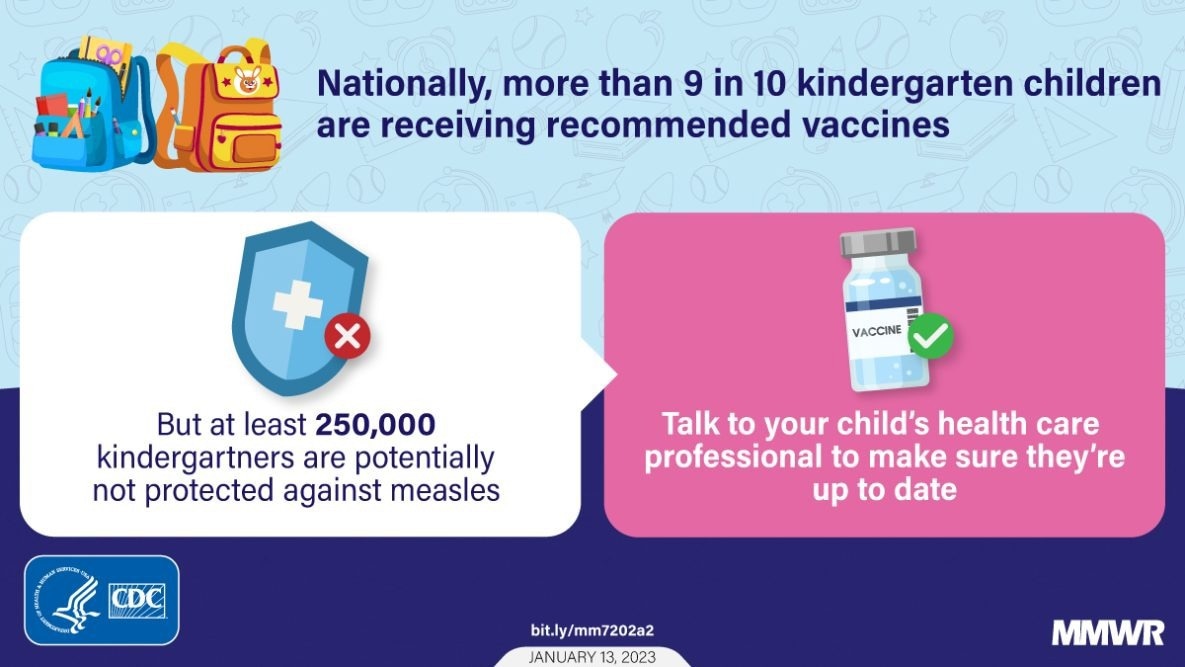Local- and state-level vaccinations can prevent diseases among students. Despite almost entirely resuming in-person learning following coronavirus disease 2019 (COVID-19)-related disturbances, vaccination programs continue to document the impact of severe acute respiratory syndrome coronavirus 2 (SARS-CoV-2) infections on vaccination coverage and evaluation. Follow-up assessments with under-vaccinated children are critical to increasing vaccine distribution to pre-COVID-19 levels and protecting pediatric individuals from developing diseases.

Vaccination Coverage with Selected Vaccines and Exemption Rates Among Children in Kindergarten — United States, 2021–22 School Year. Image Credit: CDC
About the report
In the present report, researchers described the distribution and exemption of four vaccines, i.e., the measles, mumps, and rubella (MMR) vaccine; diphtheria, tetanus, pertussis (DTaP) vaccine; the varicella vaccine; and the polio vaccine among kindergarteners in the 2021-2022 school year.
Parents supply their children's immunization or exclusion-related documents to schools as mandatory requirements for admission by local and state authorities, or schools receive information from state vaccination data registries. In addition, government-aided vaccination programs collaborate with educational departments and school employees to determine the status of vaccinations among students attending private and public kindergartens.
Unweighted estimates, aggregated based on the type of school, are reported to the CDC through the Secure Access Management System's online surveys. The CDC utilizes the statistics to generate statewide and nationwide estimates of kindergarten immunization coverage. Cities' statistics are combined with state-level data.
Vaccination coverage and exemption estimates are modified based on the types of surveys and response rates. Among US states, 27 states recorded the count of children attending kindergarten during grace periods (school attendance without evidence of full vaccinations or exemptions within a predetermined period) or interim admission (attendance at school while finishing catch-up vaccinations).
State-wise values were computed for MMR vaccine coverage (the proportion of kindergarteners who received full MMR vaccination and those who were exempt from vaccinations but possessed a documented exemption).
Results
Between 2021 and 2022, 49 US states documented vaccination coverage for all four vaccines and their exemptions among public school kindergarteners and 48 states for private school kindergarteners. Between 2021 and 2022, 3,835,130 children attended kindergarten across 49 US states, 92% of whom (n=3,536,546) participated in the vaccination surveys; 96% (n=3,686,775) were surveyed for exemption from vaccines; and 66% (n=2,527,578) were surveyed to assess grace periods and the status of interim recruitment.
Between 2020 and 2021, national-level coverage of state-required vaccines among kindergarteners decreased from 95% to 94%. In the 2021-2022 school year, national coverage of two doses of the measles, mumps, and rubella (MMR) vaccine, required doses of diphtheria, tetanus, and acellular pertussis vaccine (DTaP), and the poliovirus (polio) vaccine was 93%.
The estimates were lower than those documented for the 2020-2021 year (94%) and the 2019-2020 year (95%). National MMR vaccination coverage remained below the Healthy People 2030 target of 95% among kindergarten children. Despite 2.60% of kindergarten children being exempted from ≥1.0 vaccines due to medical (0.2%) or non-medical (2.3%) reasons between 2021 and 2022, 4.40% of non-exempted kindergarteners were not fully vaccinated against measles, and the percentage increased in most states compared to the prior year.
All except four of the 35 US states and the DC with less than 95% MMR vaccine coverage might attain coverage rates of 95% if all non-exempted kindergarten pupils within the grace period, tentatively registered, or attended school with no vaccination records were vaccinated.
Conclusions
Overall, the finding showed that national kindergarten vaccination rates dropped from 95% in previous years to 93% in the 2021-2022 school year, i.e., nearly 250,000 kindergarteners were unvaccinated and unprotected against measles, which could lead to outbreaks in the future. Increased follow-up with under-vaccinated pupils can help prevent children from developing vaccine-preventable illnesses by mitigating the impact of disruptions in vaccination coverage.
High vaccination coverage is crucial as schools return to in-person learning to safeguard children from diseases that can be prevented with vaccines. Immunization programs may locate schools that have inadequate vaccination coverage using local-level data, such as school assessments or immunization information systems.
School vaccination regulations that are strictly enforced, school-based vaccination centers, recall frameworks, and school nurses following up on under-vaccinated students could increase vaccination coverage.